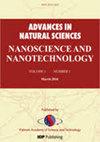Study on immobilisation process on lateral flow assay test strip for detection of Enrofloxacin antibiotic by inkjet printing
IF 2.1
Q3 MATERIALS SCIENCE, MULTIDISCIPLINARY
Advances in Natural Sciences: Nanoscience and Nanotechnology
Pub Date : 2024-01-17
DOI:10.1088/2043-6262/ad1aa0
引用次数: 0
Abstract
Enrofloxacin has been widely and increasingly used in veterinary medicine to treat infection on animals which could lead to antibiotic resistance for the consumer. Among the available detection techniques for Enrofloxacin, immunoassay lateral flow test strip is realised to be a rapid and accurate detection method for on-site analysis of Enrofloxacin antibiotic. The current study aims to analyse the application of inkjet printing technology on the immobilisation of biological substances at the test line and control line position of the test strip. With the printing parameters value at 35 °C, 35 °C, 7 layers and 15通过喷墨打印固定化工艺研究用于检测恩诺沙星抗生素的横向流动检测试纸
恩诺沙星越来越广泛地应用于兽医治疗动物感染,这可能会导致消费者对抗生素产生抗药性。在现有的恩诺沙星检测技术中,免疫测定侧流试纸被认为是现场分析恩诺沙星抗生素的一种快速准确的检测方法。本研究旨在分析喷墨打印技术在测试条测试线和控制线位置固定生物物质的应用。在墨盒温度、基底温度、打印层数和墨滴间距分别为 35 °C、35 °C、7 层和 15 μm 的条件下,制成的试纸与恩诺沙星样品在 0 至 100 ppb 浓度范围内的测试相关系数 R2 为 0.993。与传统的制造方法相比,利用喷墨打印技术的固定化工艺在打印图案方面更胜一筹,而且工艺简单、节省材料,是一种具有创新潜力和经济效益的现场检测恩诺沙星抗生素的方法。
本文章由计算机程序翻译,如有差异,请以英文原文为准。
求助全文
约1分钟内获得全文
求助全文
来源期刊

Advances in Natural Sciences: Nanoscience and Nanotechnology
NANOSCIENCE & NANOTECHNOLOGYMATERIALS SCIE-MATERIALS SCIENCE, MULTIDISCIPLINARY
自引率
4.80%
发文量
0
 求助内容:
求助内容: 应助结果提醒方式:
应助结果提醒方式:


